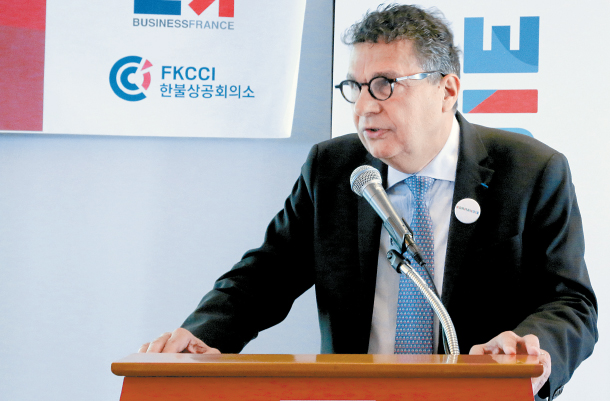CEO describes a century of Saint James stripes

President Luc Lesenecal of Saint James gives a speech at a networking event held last Monday at Hotel Lotte. He was part of a delegation of 10 Normandy companies that visited Korea last week. [FRENCH KOREAN CHAMBER OF COMMERCE AND INDSUTRY]
The 128-year old French fashion brand Saint James is the daddy of marinieres. Based in Normandy on France’s north coast, Saint James’ cotton shirts and sweaters were popular with fishermen and sailors. The fabric used was almost waterproof and blocked cold winds on the sea. Allegedly, the stripes were useful for spotting men who fell overboard.

Saint James’ flagship marinieres, or striped cotton shirts. [SAINT JAMES]
The brand is a “living heritage” acknowledged by the French government-a title given to companies that date back to before 1900 and have specific know-how in manufactured goods.
Saint James entered the Korean market in 2010 - its second market in Asia after Japan. According to Platform, Saint James’ local distributor, the brand is one of its top two bestsellers. President Luc Lesenecal of Saint James said that Korean consumers are particular not only about quality but also authenticity.
“Consumers nowadays want a brand story that’s real. It’s the same with origin. When we say we’re made in France, it’s true because we still produce all of our products at the factory in Normandy,” he said.
Lesenecal is a prominent figure in Normandy’s business scene, having formerly served as a senior executive for the Isigny Sainte-Mere cooperative in the region, which produces one of France’s most well-known butter brands worldwide, which is also imported to Korea.
He visited Seoul last week as a member of a delegation of 10 Normandy-based enterprises looking for opportunities.
Below are excerpts of his interview with the Korea JoongAng Daily conducted on Tuesday.
Q.It’s been seven years since Saint James launched in Korea. How has the performance been?
A. We entered Korea in 2010. In Japan we did so much earlier, more than 30 years ago. But it didn’t take long for Korea to narrow the sales gap with Japan. We started business here through a partnership with a multi-brand store operator called Platform and placing products in two of its branches. Now, we have four independent Saint James Boutiques and supply products to over 40 multi-brand stores nationwide, including five Platform stores.
Why do you think Saint James’ marinieres were able to survive this long in fashion history?
First, it signifies it’s made in France [amongst all other similar marinieres in the market]. And it represents chic. You can wear a pair of jeans and work comfortably in it but also match it with suit slacks. The core of Saint James’ design is casual chic.
A change I noticed in consumers worldwide is the growing tendency to value quality and authenticity at the same time. The word authenticity applies to brand stories and origin.
When we talk about our history based in Normandy and the fact that we still produce products in a village that has the same name as our brand, they’re all true. And consumers nowadays want to verify this. Saint James opens our factory to tourists.
Why is Saint James doing well in Korea?
Koreans seem to be even more particular about the two factors consumers value these days. Young Koreans travel a lot. My impression of Koreans is that they are very open to new cultures. France receives tourists from all over the world but my impression of Korean consumers is that they are not just interested in clothes in general, but also curious about the authenticity and know-how in old French brands.
Your collections don’t seem much different in design from previous releases. Saint James’ marinieres are always long-sleeved and striped.
Saint James’ products are not at the forefront of changing fashion trends. It’s a basic item. For new seasons, we change the color, upgrade the fabric or make little variations like adding buttons, but the main form of our design remains the same. It’s a little more fitted now, but Saint James’ tops basically don’t attach to the body [as its early design]. And because it was made for fishermen who bend down, it always comes down to the waist and has long sleeves. We make derivations but we want to produce “real” marinieres as they were made ages ago.
Before coming to Saint James in 2012, you worked for over two years at Isigny Sainte-Mere. This means you’ve worked at two of the most famous businesses based in Normandy. Do you have a management philosophy rooted in your career?
I was born in Lyon but I lived 34 years in Normandy and my father is originally from this region. I like buying locally-made products and I consider my roots to be here, not to mention I have great affection for living close to the sea. What I’ve come to value the most in my career working at Isigny and Saint James are the employees that work in our manufacturing facilities, and believing in the pride they have for their jobs. A routine I do every day is taking a look in the factory, which is currently run by 300 people.
It takes 18 months for a skilled worker to learn Saint James’ sewing techniques, such as attaching collars to our jumpers by hand. Anybody you talk to at the factory, you can tell he or she feels pride producing Saint James products.
BY SONG KYOUNG-SON [song.kyoungson@joongang.co.kr]










with the Korea JoongAng Daily
To write comments, please log in to one of the accounts.
Standards Board Policy (0/250자)